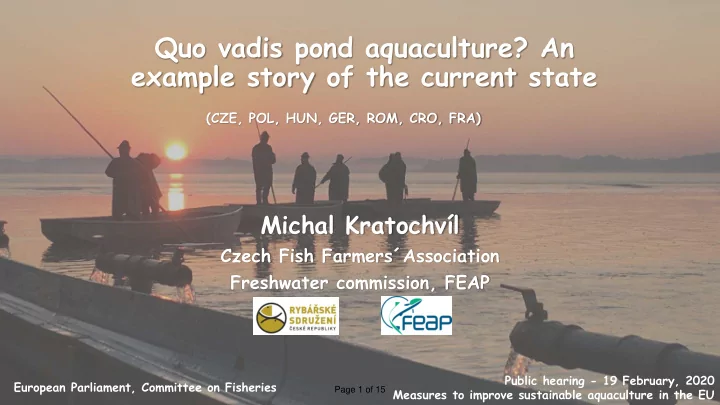

Quo vadis pond aquaculture? An example story of the current state (CZE, POL, HUN, GER, ROM, CRO, FRA) Michal Kratochvíl Czech Fish Farmers´Association Freshwater commission, FEAP Public hearing - 19 February, 2020 European Parliament, Committee on Fisheries Page 1 of 15 Measures to improve sustainable aquaculture in the EU
Pond aquaculture in the Czech Republic – cultural and historical heritage - almost one thousand years POND = man-made, shallow, historical waterbodies (NOT A LAKE!) Aquaculture: ~ 20-21,000 tons fish Angling (open waters) – recreational activity aquaculture - 42,000 ha ponds two angling unions with 350,000 members ~ 96.4 % of production 2,000 fishing grounds (app. 42,000 ha) special systems (RAS, raceways) common carp = species for anglers (80 % of catch) ~ 3.4 % of production 90 % of production = common carp Page 2 of 15
Preservation of unique pond systems (rural areas) Non-productive pond functions (ponds providing environmental services) Water accumulation, impact on microclimate accumulation and retention of surface water (groundwater), water storage in landscape Secondary wastewater treatment improvement of water quality passing through a pond – nutrient retention, transformation or elimination (particularly P, N), reduction of micropolutants Energetic utilization – small hydroelectric power stations Ecological functions – unique ecosystems with high biodiversity of fauna and flora Socioeconomic development of rural areas (employment, tourism, etc.) Page 3 of 15
Dominant fish species in pond aquaculture – common CARP - marketable size 1.5 - 3 kg (3 - 4 year-old fish) 80 % of carp - sold during December as a - efficient utilization of natural food resources traditional Christmas Eve dish (often supported by manuring and artificial feeds (cereals) supply) Page 4 of 15
Page 5 of 15
Aquaculture in the WORLD CARP in the WORLD Source: FAO FishStat 2016 – 4 556 621 tons (FAO) Page 6 of 15
(FIN)FISH in EUROPE EU COUNTRIES NON-EU COUNTRIES (Norway, Turkey, Faroe Islands, Iceland) 800.000 700.000 1.800.000 600.000 1.600.000 1.400.000 500.000 1.200.000 TONS 400.000 1.000.000 TONS 800.000 300.000 600.000 200.000 400.000 100.000 200.000 0 0 2005 2006 2007 2008 2009 2010 2011 2012 2013 2014 2015 2016 2005 2006 2007 2008 2009 2010 2011 2012 2013 2014 2015 2016 2017 YEAR YEAR common carp (ponds) freshwater species marine Source: FEAP report Source: EUMOFA sourced by EUROSTAT Page 7 of 15
Main factors affecting the pond aquaculture stagnation Nature protection POND = „ significant landscape element“ ( according to Czech legislation) • NATURA 2000 network: - Special protection areas (bird areas) • - Special areas of conservation (habitats, species) Restrictions (low fish stocking, no feeding and manuring, indirect restrictions (water manipulation, vegetation maintenance)) = loss of production, loss of income Page 8 of 15
Main factors affecting the pond aquaculture stagnation EU protection of overpopulated fish predators The great cormorant ( Phalacrocorax carbo sinensis ) issue pan-European (40 years) problem – today: 2 mil. birds; 1,000 tons of fish /day - definition of invasive species, but protected (The birds directive) European parliament – resolution 2008 FEAP - resolution 2019 – call for cormorant to be a huntable species (Annex II, The birds directive 2009/147/EC) - for shooting or scaring - derogation needed, administrative burdens (local/regional authorities) - no change in numbers and damage (hard to shoot, egg oiling efficiency) Czech Republic - 10-20 ths. overwintering birds - Direct losses = 1,500-2,000 tons/year; 3-5 mil. EUR/year - Indirect losses = difficult to calculate Page 9 of 15
Main factors affecting the pond aquaculture stagnation EU protection of overpopulated fish predators The European otter ( Lutra lutra ) issue Czech Republic - highly protected (The habitats directive 92/43/EC, no derogation) - high increase of the population - direct losses = cca 1,500 tons/year (> 3 mil. EUR/year) - partial compensation for damages, loss of breeding fish (invaluable) Page 10 of 15
Main factors affecting the pond aquaculture stagnation Decrease of production volume/area caused by enormous input of soil material to ponds (siltation) ~ 200 mil. m 3 of 600 mil. m 3 of pond capacity - filled with sediments • origin of sediments: soil erosion, primarily from agriculture areas (fields) – foremost corn planting • on steep field slopes close to streams and ponds Desiltation of ponds - expensive and can not be financed from fish production profit • Average costs (40 cm thick layer of mud) per hectar of pond area = • app. 50-70 ths EUR highly dependent on state aid Page 11 of 15
Courtesy of VÚMOP, v.v.i. Courtesy of L. Vacek Page 12 of 15 Courtesy of M. Urbánek
Main factors affecting the pond aquaculture stagnation DROUGHT IS and WILL BE A BIG PROBLEM FOR FRESHWATER AQUACULTURE!!! - no existence of fish stock commercial insurance in MS - state aid ( de minimis ) only in PL and BE - EC - preparation of new guidlines of state aid to the fishery and aquaculture sectors following the new EMFAF, drought should be included Page 13 of 15 Courtesy of http://udalostionline.cz
Summary European freshwater (inland) aquacuture – stagnation of the sector over decades Pond farming - not only fish products supply, but also providing positive externalities (environmental services, landscape formation, socioeconomic development in rural areas) Measures to improve sustainable pond farming and the potential for growth exist , but… under attacks of fish predators, nature protection restrictions, administrative burdens (bureaucracy), high siltation, climate change (drought) and others … pond farming will be hardly profitable, not allowing the further development of the sector. EU and MS decisions – POND FARMING fish production OR open-air museum? Page 14 of 15
Thank you for attention Page 15 of 15
Recommend
More recommend